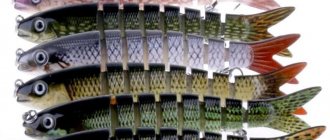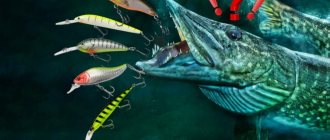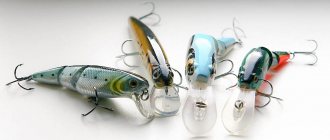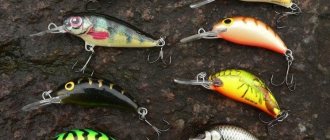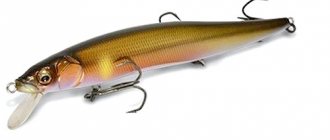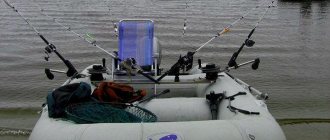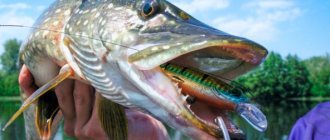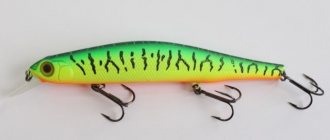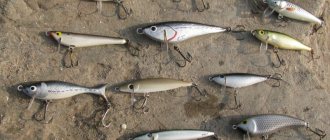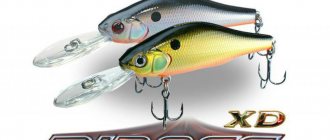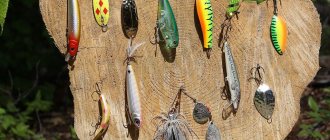Zip Baits Rigge 35F
We should start the review with the legendary Rigge model. The size range of these wobblers is very wide; there are models of different “heights” that have different buoyancy. But that’s not all: there are bladeless models Raphael and Dimly - sinking “slalom” wobblers with an S-Line effect. But now a few words about the smallest Rigge, about the people’s favorites - “thirty-fifths”.
The most important advantage of the Rigge 35 is that there is probably no fish that these “babies” could not seduce. For a long time, the mini-sized Rigge family was represented, perfectly complementing each other, by only the “sweet couple” - Rigge 35F and Rigge 35F Deep. But then Zip Baits came up with a third bait - Rigge 35SS (weight 2.2 g).
And we also had a wobbler with negative buoyancy in our arsenal. Having only this glorious trinity in the box, you can catch almost any fish on any body of water without much hassle. It’s just a pity for this very fish, since now it has only one chance to survive - to get hooked by a fisherman who preaches the “catch and release” principle. All other meetings with the Rigge troika are simply contraindicated for underwater inhabitants.
How to fish correctly with a wobbler - tips
Without game, this type of bait is practically useless, so before you start catching someone, you will have to familiarize yourself with the theory.
In summer, pike are not very active and hunt at the edge of the current - which means you need a bait that will move with the current and not too fast. In autumn, pike, on the contrary, are very active and feel excellent - a wobbler with small twitching movements is best suited for it, which will flash past and awaken the hunting instinct in it. Spring sleepy bass do not respond well to fast targets and are not interested in prey swimming near the surface. This means that he needs a sinking option that imitates the movement of a sluggish falling asleep fish. Before you catch something, you need to find out how the prey of a particular predator behaves and try to imitate its behavior. No matter how good the bait is and no matter how great you play with it, no one will bite on it if that someone is simply not nearby. Before you fish, you need to know where your prey is found. Look for snags under which pikes are found. Look for perch that have come out to hunt in shallow water. Even if you have found a predator's hiding place, he may not want to hunt. Waiting for pike on a sunny day, for example, is almost hopeless. It’s worth knowing in advance when to fish. Fishing with a wobbler is an interesting activity that requires imagination and a light hand. To portray a small fish, to seduce a predator to rush for plastic nonsense - art and passion, known to any good fisherman. Source
Lucky Craft Cra-Pea
This “family” includes several models, which, in turn, are represented by wobblers with different working depths. Most often I use two representatives: Flat CRA-PEA MR (length 35 mm; weight 2.5 g) and Deep CRA-PEA (length 34 mm; weight 3.3 g).
They have the active play inherent in classic crank models. If you need to fish at a depth of up to 1.5 m, the Flat CRA-PEA MR comes into play. If a deeper working horizon is needed, then the Deep CRA-PEA, which easily reaches a depth of 2 meters, acts as a “getter”. The main place where this “sweet couple” is used is in pre- and post-roll pits.
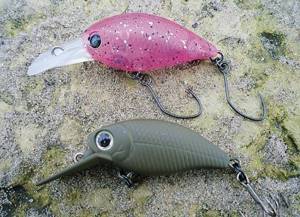
STRIKE PRO MIDGE
STRIKE PRO MIDGE
There are a great many reviews of this wobbler. Well, never mind, there will be one more. Midzhik from Strike Pro is a real find! At a cheap price, the wobbler works like expensive mini-wobblers from famous brands. I bought this wobbler after a random fishing trip. I was catching perch on a small lake. There were many fishermen on the shore who were also “performing” around the perch. Some crushed, some played with wobblers. I kept an eye on the Twitchingists, because I myself also fished with jerk wiring on small minnows. My gaze fell on the fisherman, who more often than others took bass out of the water. According to my calculations, he even caught me. Eh, the spirit of competition... I didn’t look at it for a long time - I went to get acquainted and see what I was biting on. And they pecked at Mijik! The fisherman willingly shared information with me. Moreover, he demonstrated the game of bait in shallow water. The wobbler impressed me! When I got home, I ordered 5 Mijiks through the online store. Two days later they were with me. Under the light of the table lamp, I took a closer look at this beast. But the beast is still the same! The workmanship is a C grade, the hooks are bullshit (I immediately replaced them with gamakatsu). Well, how can it “shoot”? Mystery. But the fact remains a fact. And he fully confirms that even among cheap baits there are masterpieces.
Since then, Mijikis have become my most needed wobblers. Because of their low cost, I fish with them where I would never put an expensive wobbler. I mainly fish for pike and perch using Midjay. Chub is caught as by-catch (very rarely). The wob plays seductively on a uniform retrieve; with a short steel leader it hangs in the water like a suspender, which makes it effective during pauses. And, of course, it perfectly imitates a rushing fry in any kind of jerk. I recommend that everyone who likes to catch small minnows urgently buy 5 midges (the price will be the same as a branded wobbler of a similar class). After several fishing trips with Midge, you will be simply amazed at the performance of the wobbler.
Zip Baits Hickory
Another series from Zip Baits that deserves a few kind words consists of two “adult” Hickory models and two “children” - Baby Hickory. All four Hickory representatives have long established themselves as baits that are in high demand among many fish in various types of reservoirs.
The main trump card of the entire glorious family is fishing on rifts, where, depending on the required depth, one or another Hickory model is used.
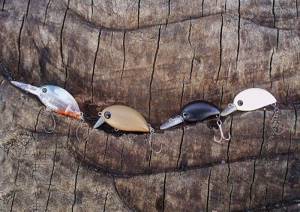
Yo-Zuri L-Minnow 33
The wobbler is a legend that cannot be ignored. For many years now, the L-Minnow has been popular with numerous spinning fishing enthusiasts, and hardly any other model can boast of such a number of conflicting responses.
And it is the “thirty-three” model that stands out significantly from the other two. If we try to briefly describe the L-Minnow 33, then nothing can be said other than “complete unpredictability”.
Often, when fishing at permanent spots, it is impossible to even approximately predict whether this representative of Yo-Zuri will be successful with underwater inhabitants or not. Often the fish completely ignores the wobbler, but it also happens the other way around: it only bites on the “thirty-third”.
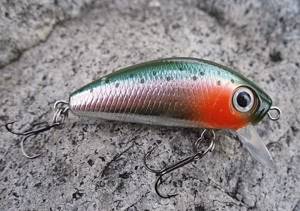
ZipBaits Rigge
ZipBaits Rigge
Legend! There's nothing more to say. Believe it or not, I only bought Ridzhik last year =) Oh well, that’s not what we’re talking about. Earlier. When I read reviews about wobblers, I was frozen out by posts where anglers claimed that “only one wobbler worked for them, and all the others were silent.” I really didn't have this. If the fish bites, you can catch it with different models and types of bait. So I thought until the devil took me to a small reservoir where there were perch and small pike perch. I fished many wobblers, but could not get consistent bites. Once every 10 wires, some kind of socket caught on the tees and that was that. Out of boredom, I began to methodically bathe all the wobblers from the box. At some point, the time came for Ridzhik 35... Believe it or not, the bite started on him! The fish were caught on almost every cast. I changed the wobbler for another - nothing. I put Ridge back and it was biting again! After this incident, I became convinced that in some situations only one model can work. Need I say that I have the deepest respect for 35th Ridge?
Jackson Kumo Lures
A very believable bait. Looking at the appearance of Kumo Lures, it immediately becomes clear for what fishing conditions this “spider bug” was created. The body length of the “insect” is 25 mm; weight 1.7 g.
Available in two versions: smooth and velvety body. Thanks to its great positive buoyancy, it is an unsurpassed leader when fishing in a way in which the wobbler is delivered by the current to a promising place that is difficult to reach for casting, and the wiring itself is carried out obliquely with drift or simply against the current.
In places where trees grow directly above the river and branches hang almost to the water, Kumo Lures always acts as one of the main providers.
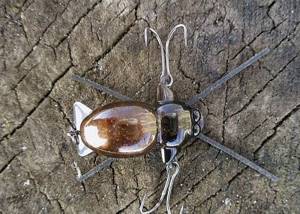
Jackson Akkan Bem 20F
Another “miracle” from Jackson. The length, or more appropriately the diameter, since the wobbler is round (which is why it received the nickname “bun”), is 20 mm; weight 3.5 g. The bait is floating. This is a very good addition to the previous model.
The “bundle” of these two baits works just fine: if the fish only responds to baits passing on the surface of the water, then Akkan Bem is used, but if the fish responds to slightly deeper wobblers, then Kumo.

Video
It is believed that fishing is a very expensive pleasure. However, since the baits are used repeatedly, the price is quite affordable. As an example, we have presented for you the 10 best budget baits. Enjoy!
(
10 ratings, average: 3.80 out of 5)

Margarita Pavlova
I am writing in the sections “Household Appliances” and “For Children”.
Internet journalist, copywriter with 8 years of experience and simply a creative person. I create interesting texts, immersing myself in every topic. I have a higher pedagogical education, I like order in everything, and I am interested in new fashionable devices.
Jackson Cyarl 25s
Another “miracle” from the same manufacturer. A very remarkable “frog” (length 25 mm; weight 1.9 g), with pronounced negative buoyancy. Cyarl's main field of activity is exits from pits.
It is especially good during periods of high water, when the fish are at the very bottom and can only be seduced by bottom fishing. The main thing that needs to be done right away is to calculate the diving speed of the Cyarl in the place of the upcoming fishing.
And when the wobbler reaches the required depth, perform slow, non-stop wiring. It is the smoothness, without any fussiness, that allows this “frog” to show very good results.
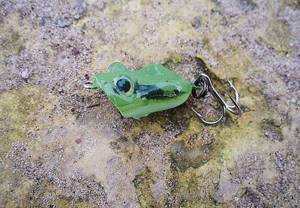
Megabass X-30
Without the most authoritative Megabass, no review of spinning lures would be complete. It is quality, regardless of size, that all representatives of the rather numerous “X family” are famous for.
The X-30 model, which has a length of 33 mm, is available in two versions: floating - weighing 1.2 g and sinking - 1.5 g. The first (floating option) is preferable when fishing by rafting, when the fish reacts to bait in the surface layer of water.
If you need to move the wobbler a little deeper, then sinking is the “hunting” option. Both baits complement each other perfectly when fishing on medium and small rivers.
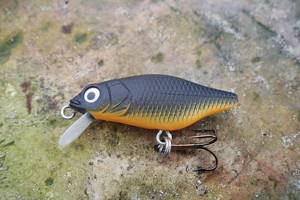
Classification of wobblers
Volumetric solid bait for fishing for large predators is used by casting by trolling or spinning.
According to the degree of floating:
- Designation FF (Fast Floating) - fast ascent speed.
- SF (Slow Floating) - ascent occurs slowly.
- F – the model can float.
- SP libr SU (Suspending) – neutrally rising figures. Being at depth, these models remain motionless.
- SSS (Super Slow Sinking) is a slow sinking product.
- SS (Slow Sinking) - long-sinking figures.
- S (Sinking) - sinking baits.
- FS (Fast Sinking) - instantly sinking.
According to the work horizon:
- Symbols SSR (Super Shallow Runner) - the webbler is located on the surface of the water.
- SR (Shallow Runner) - surface deepening.
- DD (Deep Diver) or DR (Deep Runner) - strong immersion.
- SDR (Super Deep Runner) - dives a little deeper than previous models.
- XDD (Extra Deep Diver) - maximum dive level.
By form:
Crawler (crawler) - thanks to the wide blades, the figure rotates in different directions, which is especially convenient in conditions of large vegetation:
- Stickbait (stickbait) - resembles a stick, and is capable of changing the behavior of the bait.
- Popper (popper ) - distinguished by a cut off nose and a medium-sized recess.
- Walker - during wiring, it is able to move from side to side.
- Cicada is a dummy of frogs and other rodents.
- Popper - the model is equipped with a propeller that creates a riot when entering.
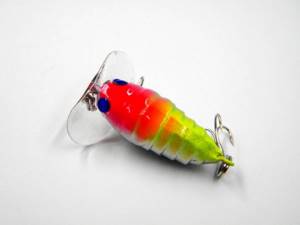
Popper crawler
Daiwa Presso
There is no escape without Daiwa in our spinning affairs, especially in the review of wobblers. A whole series is produced under the general name Presso, which includes both the mini-lures themselves and the gear for their use.
The photo shows minnows - Presso Minnow (length 40 mm; weight 1.8 g); two cranks - Presso Kp Crank (length 35 mm; weight 3.0 g) and Preso Kp Crank DR (same length, but weight 3.3 g). The main place of application is small rivers and rapids areas.
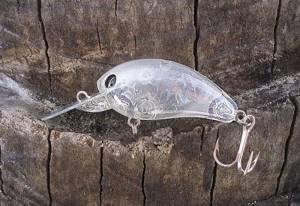
The two Presso spinners (top model called Rave, 24 mm long and weighing 1 g; below Witch 30 mm long, weighing 1.4 g) are originally painted blue and equipped with single barbless hooks. When carried evenly, waddling from side to side, they play with their rear end cheerfully and seductively. Indispensable when fishing for perch, chub, ide, trout and even grayling.
They are “friendly” with the current, but not very strong. Often in hot weather in summer they turn out to be more catchy than many models of wobblers and spinners; Witch does this especially well.
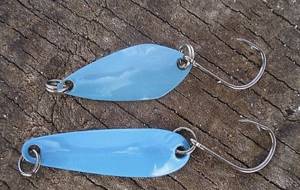
Ultralight wobblers
Date: May 10, 2021 | 215
The concept of fishing with a spinning rod has undergone quite significant changes over time, new trends, gear, and entire classes of baits have appeared. Moreover, these changes, in some places, occur very quickly, right before our eyes, right in a matter of years. I remember how, as a child, spinning baits and spinners with sizes ranging from 6-8 cm and above were the norm for us. And the weight of such baits sometimes reached 25-30g. But, time passed. The fish became less and less. In response to this, the gear became thinner and the baits became smaller and lighter. This is how ultralight came into use - a class of spinning rod that involves the use of small and light baits. It’s clear that a significant part of the arsenals of ultralight spinning rods consisted of ultralight wobblers . Mini wobblers will be discussed in today’s article.
What is an ultralight wobbler and how to distinguish it from the huge variety of baits available on sale today. In this matter, I rely solely on the weight of the bait. Because The test range of ultralight tackle (ultralight spinning rod) must match and include the weight of the wobbler. There may be discrepancies on this score, but, for me, an ultralight wobbler is a bait weighing no more than 5g. Even, usually, the upper weight threshold is around 4g, or a little more, up to 4.2-4.5g. So, it turns out that wobblers whose weight is in the range from 1-1.5g to 4.5-5g can be considered ultralight. Well, and, accordingly, when using an ultralight spinning rod with a test of 0-5g, or 1-7g, the bait and tackle are perfectly combined.

Of course, ultralight spinning can be even more elegant, for example, with a dough of up to 3g. In this case, we will not be able to use all ultralight wobblers, but only those that will not overload the tackle. So, these may not be persistent minnow or shad wobblers weighing up to 3g. If we are talking about rollers that create significant drag, then they should be selected with a weight of no more than 2-2.5g. Like this.
What does the low weight and small size of the wobbler give? And why are ultralight style and ultralight baits so popular today?
Firstly, in most reservoirs we have problems with the number and size of predatory fish. Large specimens are rare. And in order to catch the ubiquitous perch, medium-sized pike and zander, small baits are better suited, in particular, mini wobblers that fall under the UL category.
Secondly, small ultralight wobblers perform well when catching not only predatory fish, but also semi-predatory species and completely peaceful fish. This, of course, significantly expands the list of potential trophies and makes fishing more diverse, interesting, and intriguing. After all, it’s always cool when you can catch not only pike, perch, pike perch, but also, for example, large carp, using elegant tackle... And so, with ultralight mini-wobblers they successfully catch: ide, chub, asp, large rudd, carp , crucian carp and many other unexpected fish.
Today, ultralight wobblers are widely used in reservoirs of various types, from small ponds to shallow waters of quite decent bays, lakes, reservoirs, both on standing reservoirs and on fast rivers.
Naturally, fast streams and rivers put forward their own demands on the quality of the wobbler, on its ability to play in the current, and not go into a tailspin in a fast stream. So, if in still water, even cheap Chinese mini-wobblers are able to show a passable game and result, then when fishing in fast streams, it is better to give preference to “thoroughbred” Japanese baits.
As for the wiring of ultralight wobblers, it is individual for different models. Most wobblers, of course, have their own game on a uniform retrieve. They can be carried out simply evenly, with stop-and-go wiring, or twitched and twitched. But, there are also purely twitching models, mainly among minnow class wobblers.
Well, we found out what this class of bait is - ultralight wobblers. And they gradually came to the conclusion that, like others, ultra-light class wobblers are divided into types based on their shape. These are minnows, shads, cranks. Minnow wobblers are distinguished by a narrow, elongated body, Shad have a rather high body and are flattened on the sides, and Crank are thick, voluminous, more stubborn in wiring and create strong high-frequency vibrations. Now, I will give several examples of ultralight wobbler models that belong to each type.
Ultralight wobblers Minnow
Yo-zuri L-Minnow . Classic wobblers that have earned universal recognition in the spinning community. The bait is presented in three sizes, and small, 3.3 cm, as well as medium, 4.4 cm, are included in the UL range.
ZipBaits Rigge 35 . Perhaps this is one of the most famous UL wobblers of our time. This Japanese-made baby simply breaks records for the species diversity of fish caught. Wobbler length 3.5cm, weight – 2g, 2.2g, depending on the version (floating, sinking, diver).
In addition, this wobbler, although small and light, is equipped with a long-distance casting system. Which, of course, is wonderful!
In addition, there are many clones of this legendary bait on the market. For example, these are: Kosadaka Ion XS, Strike Pro Archback and Silver Stream Combek. It is clear that the casting distance and balance of these copies are not as perfect as the Japanese original. But they also catch, and when fishing in weak currents and in calm water, they are not inferior at all.
Pontoon 21 Crackjack . This is a fairly extensive family of minnow wobblers. There is also an ultralight version. Thus, Crackjack wobblers measuring 3.8cm and 4.8cm weigh up to 4g and are clearly included in the UL range.
Strike Pro Midge . A cheap and very popular ultralight minnow wobbler. Length – 4cm, weight – 2g.
Jackall Tiny Fry . A very good mini-minnow.
Ultralight wobblers Shad
Pontoon 21 Cheerful . An extensive family of ultralight mini-wobblers for shad. The smallest version is 3.4cm long and weighs 1.6g.
Pontoon 21 Alter Idem . A small original shad wobbler that fits perfectly into the ultralight segment according to its parameters: length from 3.6cm to 4.2cm, weight from 2g to 3.3g.
Strike Pro Baby Pro . Strange wobbler. Almost round profile, but due to the flattened sides, I would still classify it as a shad. Length 2.5cm, weight – 2g. The wobbler is cheap, accessible, widespread, and has many positive reviews. It is clear that there are not many good budget UL wobblers.
Ultralight wobblers Crank
Jackall Chubby . Perhaps one of the most famous and popular ultralight wobblers. Although it can be classified as a FET pot-bellied wobbler, these families have a lot in common and there are quite a few models of wobblers that are difficult to clearly classify as crankbaits or fats. Chabik is just one of them. Excellent series of UL wobblers. There are models with different immersion depths, from zero to divers. The length of the wobbler is , the weight is within the range, depending on the model.
Jackall Area Man Crank . Miniature cranks. The smallest model, only 2.2cm long and weighing 1.1g!
Smith Camion . A series of famous Japanese cranks. Lures work great in currents. Wobblers are catchy. There are several models that differ slightly in weight and size.
There are also quite successful clones of these ultralight cranks, in the form of the Kosadaka Roger series. They are incomparably cheaper, but not so good in noticeable currents. In calm water - excellent wobblers.
ZipBaits Baby Hickory . Cool Japanese mini rolls. Very good, including for fishing in the current. Length – 2.5cm, weight – 2.6g.
Nories Pupa . Interesting mini wobbler-beetle. Length 3.5cm, weight 2.6g.
Salmo Hornet . Famous series of cranks. There are several small models that fall into the UL group. These are wobblers in sizes: 2.5cm, 3.5cm, 4cm. The weight ranges from 1.5g to 4g.
Salmo Tiny . Mini-wobbler imitating a beetle. Wobbler length - 3cm, weight - 2g.
Skagit Designs Cookies . Cool crank wobbler. Good, but not in the strongest current.
Tsuribito Baby Crank . Another popular mini-crank that falls under the ultralight category. There are floating and sinking versions, with medium diving depth and divers. Length 3.6cm, weight 3.1-3.6g.
Asakura S-Hornet . An excellent crank, along with the previous one, Tsuribito, this is one of my favorite mini-wobblers when catching small chub. The wobbler is equipped, although simple, with a long-distance casting system.
This wobbler has a quite digestible clone - Usami Shikima.
* * *
These are the models of ultralight wobblers that, in my opinion, deserve attention. What UL wobblers do you use? Well, or which ones are you going to buy? Share in the comments.
Share with your friends:
Category: Tackle Equipment
Tags: Wobblers, Lures, , Ultralight
Angler's Republic Water Plane and Bug Minnow
The famous Bug Minnow is the smallest and most honored of the “little ones.” Almost any fish can be caught with it, even bleak becomes a bloodthirsty predator at the sight of this baby.
The purpose of the Bug Minnow in my arsenal is to catch trout and grayling. The Water Plane model lives up to its name and is a small airplane. At first I thought that this exhibit would take its place among other similar souvenir examples of wobbler construction, but it turned out that the “water plane” copes well with its main purpose - to catch fish.
Water Plane has all the properties of a crank, exhibits medium-active play, and is stable in the stream. Without much difficulty it seduces perch, small pike, chub and ide.
